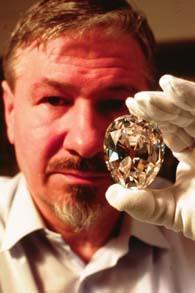
December07
The Cullinan Diamond
Article by: Joseph Denaburg
There are many large, famous diamonds, but the biggest gem-quality diamond ever found was the Cullinan Diamond that weighed in at 3,106 carats. The stone was discovered by a miner employed by the South African Premier Mine by the name of Thomas Evan Powell in 1905. It was named after the owner of the mine, Sir Thomas Cullinan.
Analysis of the Cullinan diamond revealed astounding clarity but also a black spot in the middle. The colors around the spot were brilliant and vacillating as the stone was turned; this indicated strain in the stone, a not uncommon trait of diamonds. It was then purchased by the Transvaal government and given to King Edward VII on his birthday.
In the early 20th century, jewelers did not have access to the technology used today and cutting the diamond was considered a difficult, risky task that could very well end in disaster. Joseph Asscher of Amsterdam, said to be the most skilled cleaver of his time, managed to split the stone in half precisely through its defect. It is said that the knife broke in the first attempt but when the stone finally broke it fell apart as two perfect halves. It was then cut into thirds and eventually into 9 large gem-quality stones and 96 minor stones. The South African government eventually bought the major stones and gifted them to Queen Mary in 1910.
The largest of the major stones that were cut and polished from the Cullinan was Cullinan 1, also known as the Great Star of Africa totaling 530 carats. It was the biggest polished diamond in the world until 1985 when the Golden Jubilee Diamond (545 carats) was found. The Cullinan I, a pear shaped gem, now sits in the head of the Sceptre with the Cross, a sceptre that was crafted for the coronation of King Charles II in 1661. It was redesigned to hold the Cullinan I, which can be removed in order to be worn as a brooch. The Cullinan II, the second largest gem from the original stone, also known as the Lesser Star of Africa, is 317 carats; it is the 4th largest polished diamond on earth and cut in a rectangular cushion cut. Cullinan II now sits in the Imperial State Crown and can be combined with Cullinan I as a brooch. Both stones are part of the Crown Jewels of the United Kingdom.
The remainder of the 9 stones became part of the Cambridge and Delhi Dunbar Parure, a suite of emerald and diamond jewelry that was crafted by the crown jewelers for the coronation of King George V in 1911; Mary and George were proclaimed Emperor and Empress of India at a Dunbar in Delhi in December of 1911. Cullinan III, a pear shaped 94 carat stone now is part of a brooch that includes the Cullinan IV, a 63 carat square cushion diamond that was originally the centerpiece of the parure’s tiara. The 18.8 carat heart-shaped Cullinan V was originally part of the stomacher of the parure, a triangular shaped panel that was meant to fill the front opening of a woman’s gown or be attached to the bodice. Cullinan VI, an 11.5 carat marquise cut, was set as a pendant in the parure’s diamond and emerald necklace. Cullinan VII and Cullinan VIII are also part of the stomacher. Cullinan IX is a pear shaped 4.4 carat stone that was set as the bezel in a platinum ring for Queen Mary in 1911.
Speculation persists that the Cullinan diamond is but one fragment of an enormous octahedral crystal, the rest of which is awaiting discovery deep in the bowels of Africa.

